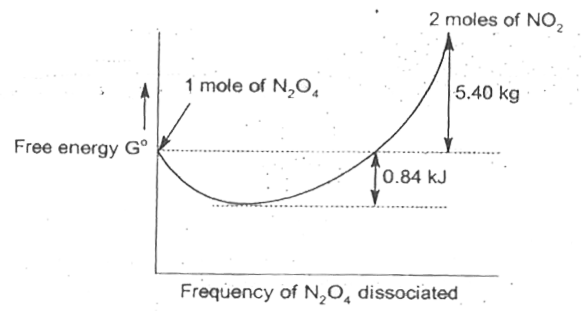What is the free energy change (ΔG) for galvanic and electrolytic cel ?
To determine the free energy change (ΔG) for galvanic and electrolytic cells, we can analyze the characteristics of each type of cell.
1. Understanding Galvanic Cells:
- Galvanic cells, also known as voltaic cells, are electrochemical cells that convert chemical energy into electrical energy through spontaneous redox reactions.
- In a galvanic cell, the free energy change (ΔG) is negative, indicating that the reaction occurs spontaneously.
Formula:
ΔG<0
This means that the process is exergonic, and energy is released during the reaction.
2. Understanding Electrolytic Cells:
- Electrolytic cells, on the other hand, use electrical energy to drive a non-spontaneous chemical reaction. This means that an external power source is required to make the reaction occur.
- In an electrolytic cell, the free energy change (ΔG) is positive, indicating that the reaction does not occur spontaneously.
Formula:
ΔG>0
This means that the process is endergonic, and energy must be supplied for the reaction to take place.
3. Summary of ΔG for Both Cells:
- For Galvanic Cells:
ΔG<0(Spontaneous reaction, exergonic)
- For Electrolytic Cells:
ΔG>0(Non-spontaneous reaction, endergonic)
Final Answer:
- Galvanic Cell: ΔG < 0 (spontaneous, exergonic)
- Electrolytic Cell: ΔG > 0 (non-spontaneous, endergonic)
- Galvanic cells, also known as voltaic cells, are electrochemical cells that convert chemical energy into electrical energy through spontaneous redox reactions.
- In a galvanic cell, the free energy change (ΔG) is negative, indicating that the reaction occurs spontaneously.
ΔG<0
This means that the process is exergonic, and energy is released during the reaction.
- Electrolytic cells, on the other hand, use electrical energy to drive a non-spontaneous chemical reaction. This means that an external power source is required to make the reaction occur.
- In an electrolytic cell, the free energy change (ΔG) is positive, indicating that the reaction does not occur spontaneously.
ΔG>0
This means that the process is endergonic, and energy must be supplied for the reaction to take place.
- For Galvanic Cells:
ΔG<0(Spontaneous reaction, exergonic)
- For Electrolytic Cells:
ΔG>0(Non-spontaneous reaction, endergonic)
- Galvanic Cell: ΔG < 0 (spontaneous, exergonic)
- Electrolytic Cell: ΔG > 0 (non-spontaneous, endergonic)
Topper's Solved these Questions
- BOOK - CENGAGE CHEMISTRY ENGLISHCHAPTER - NCERT BASED EXERCISEEXERCISE - Electrolysis, Batteries , and Rusting20videos
NCERT BASED EXERCISE
- BOOK - CENGAGE CHEMISTRY ENGLISHCHAPTER - NCERT BASED EXERCISEEXERCISE - Conductivity of Ionic Solutions8videos
NCERT BASED EXERCISE
- BOOK - CENGAGE CHEMISTRY ENGLISHCHAPTER - NCERT BASED EXERCISEEXERCISE - Short Answer Type Questions(ElectroCHMmical Cell)4videos
NCERT BASED EXERCISE
- BOOK - CENGAGE CHEMISTRY ENGLISHCHAPTER - GRIGNARD REAGENTS AND ORGANOMETALLIC REAGENTSEXERCISE - Exercises Archives (Linked Comprehension)1videos
GRIGNARD REAGENTS AND ORGANOMETALLIC REAGENTS
- BOOK - CENGAGE CHEMISTRY ENGLISHCHAPTER - NUCLEAR CHEMISTRYEXERCISE - Archives Subjective13videos
NUCLEAR CHEMISTRY
Similar Questions
The free energy change ΔG=0, when
View SolutionThe free energy change, ΔG = 0, when
View SolutionThe relationship between the free energy change (ΔG) and entropy change (ΔS) at constant temperature (T) si
View SolutionFor a chemical reaction, the free energy change (ΔG) is negative. The reaction is
View SolutionGibbs Free Energy
View SolutionFree energy is the one
View SolutionWhat is the free energy change, 'ΔG' When 1.0 mole of water at 100∘C and 1 atm pressure is converted into steam at 100∘C and 1 atm pressure
View SolutionThe free energy change due to a reaction is zero when
View SolutionGibbs-Helmoholtz equation relates the free energy change to the enthalpy and entropy changes of the process as
(ΔG)PT=ΔH−TΔS
The magnitude of ΔH does not change much with the change in temperature but the energy factor TΔS changes appreciably. Thus, spontaneity of a process depends very much on temperature.
A reaction has value of ΔH=20kcal at 200K , the reaction is spontaneous, below this temperature, it is not. the values ΔG and ΔS at 200K are, respectivelyView SolutionA reaction is spontaneous if free energy change ΔG , for the reaction is negative . The question arises, how we can explain , the spontaneous of reversible reaction taking the example of dissociation equilibrium N2O4⇔2NO2(g) the variation of free energy with the fraction of N2O4 dissociated under standard conditions is shown in the figure below.

When 2 moles of NO2 change into equilibrium mixture the value of ΔG∘ isView Solution

